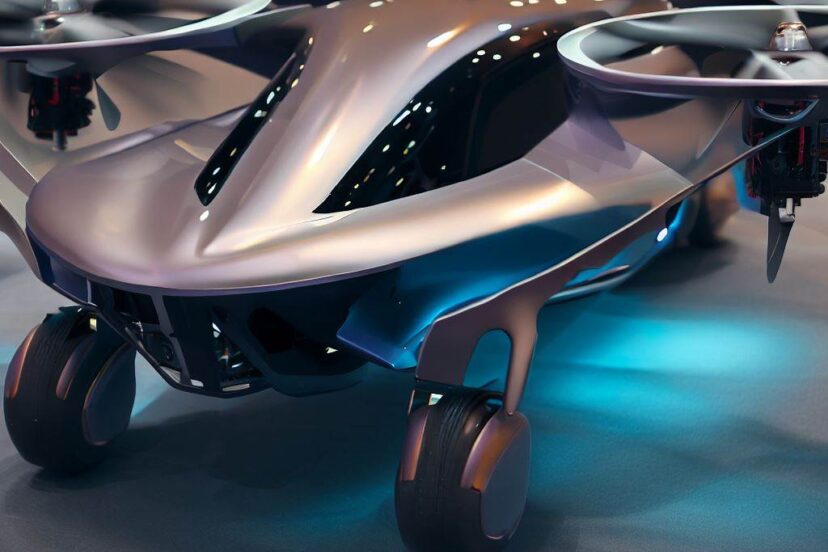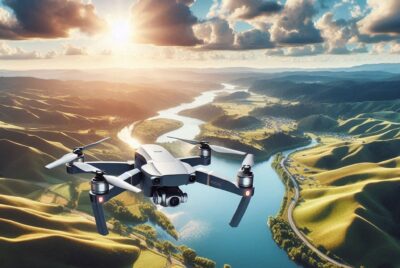Drone Car Revolution: Bridging the Skies and Roads
*We may earn a commission for purchases made using our links. Please see our disclosure to learn more.
Drone Car Evolution: Navigating the Future of Autonomous Transportation
A drone car represents an innovative blend of aerial and ground-based transportation, utilizing the technology behind unmanned aerial vehicles, commonly known as drones, to revolutionize how we perceive personal and commercial mobility. The concept is relatively straightforward yet technically complex; envision a vehicle capable of navigating both the road and the sky, providing a seamless transition between driving and flying. This dual functionality not only promises a new level of convenience but also challenges traditional notions of urban transportation infrastructure.

I have observed that the appeal of drone cars lies in their potential to significantly reduce traffic congestion on city streets and highways by taking advantage of the underused airspace. As urban populations continue to grow, the efficiency and speed of travel offered by flying capabilities can’t be overlooked. Moreover, the integration of autonomous technologies promises to enhance the safety and reliability of drone cars, making them capable of autonomous operation without direct input from a human operator, which meshes well with ongoing trends in vehicle automation and smart city developments.
The market for drone cars is emerging, with various companies like Jetson accepting preorders for personal flying vehicles designed primarily for recreation. Nevertheless, the broader implications of drone cars extend beyond leisure, potentially transforming industries like logistics, emergency services, and public transportation. As with any evolving technology, there are challenges to address, including regulatory approvals, public safety concerns, and the development of supporting infrastructure, but the groundwork is being laid for these versatile vehicles to take to the skies.
Concept and Evolution of Drone Cars

Drone cars, often imagined in science fiction, are becoming a reality as they blend advanced technology with transportation concepts. Initially, the concept of drone or flying cars was a fantastical idea limited to the realm of futuristic novels and films. However, the evolution of these vehicles mirrors the rapid innovation within the automotive and aviation industries.
The transition from mere concepts to actual prototypes has accelerated in recent years. Companies like SkyDrive and models such as the Jetson One have started carving a place in the burgeoning industry. These vehicles typically combine the convenience of road travel with the ability to take off and land vertically, offering a solution to urban congestion and aiming to redefine personal mobility.
Advancements in drone technology have played a pivotal role, enabling flying cars to operate using sophisticated propulsion systems. These include electric motors and rotors that facilitate aerial movement. Automated features for navigation, along with takeoff and landing, are fundamental attributes of these prototypes to ensure user-friendly experiences.
Businesses within the industry continue to tackle a host of challenges, from safety to regulatory compliance, before drone cars can become commonplace. Nonetheless, the advancement from early concepts to workable prototypes indicates a significant shift towards more versatile and efficient forms of transportation, promising a profound impact on how I might commute in the future.
Technical Specifications and Design

In this section, I’m going to detail the intricacies of drone car design, focusing on the core components that enable their unique capabilities, such as aerial and autonomous operations.
Propulsion and Flight Mechanics
Drone cars employ electric motors and propellers to achieve lift and propulsion. Unlike traditional vehicles, these cars are equipped with a flight computer that meticulously governs flight dynamics. The combination of these elements ensures efficient maneuverability through three-dimensional space. For instance:
- Electric Motors: Typically use high-torque designs to provide immediate thrust for takeoff.
- Propellers: Often designed with variable pitch to enhance control during flight.
Safety and Autonomous Features
Safety features are paramount in the design of drone cars. A ballistic parachute system can serve as a fail-safe in case of propulsion failure. Lidar sensors contribute to a sophisticated collision avoidance system, detecting obstacles to maintain a safe distance. Key autonomous features include:
- Auto-landing System: Facilitates safe descent and precise landings with minimal input.
- Collision Avoidance Systems: Utilize real-time data to prevent in-air incidents, often backed by advanced algorithms for rapid environmental assessment.
Drone cars integrate these sophisticated technologies to ensure a balance between performance and safety, striving for a future where transportation is not only efficient but also secure.
Drone Car: Regulatory and Infrastructure Considerations
Exploring the future of urban aerial mobility through drone cars necessitates a focus on the intricacies of regulatory frameworks and the evolution of city infrastructures. Both are fundamental to safely integrating these vehicles into everyday life.
Regulatory Framework and Approvals
My examination begins with understanding that regulatory frameworks are crucial to drone car deployment. European nations and Japan have been pioneering in developing regulations for drone cars, often operating within what’s known as a “grey zone”—an interim phase before formal laws are established. For instance, the anticipation of drone cars spurred:
- Europe: To draft regulations that address the technological and safety concerns surrounding the integration of drone cars.
- Japan: To modify its aviation laws to accommodate the testing of drone vehicles, focusing on safety and privacy concerns during the “grey zone” period.
It’s a delicate balancing act requiring governmental agencies to firmly establish safety standards while fostering innovation. These standards must be operable within densely populated cities where the impact is most significant.
Urban Infrastructure and Traffic Management
In discussing infrastructure, it’s evident that existing urban layouts will require significant updates to accommodate drone cars. City planners and engineers are tasked with:
- Designing and erecting Vertiports: Dedicated areas for safe landing and takeoff.
- Implementing advanced traffic management systems to avoid mid-air conflicts and ensure efficient vehicle flow.
Traffic management, particularly in urban areas, faces a complex overhaul to integrate drone cars with current and future transportation systems. The architecture of cities must evolve, reflecting a harmony between the legacy ground-based infrastructure and the novel demands of aerial mobility.
To summarize, as I delve into the regulatory and infrastructure requirements for drone cars, it’s evident that comprehensive planning, robust standards, and forward-thinking city designs are indispensable for a future with safe and efficient urban air mobility.
Drone Car – Market and Industry Impact
As the drone car industry evolves, I find its trajectory increasingly influenced by consumer behavior and sustainability measures. This sector could potentially reshape the car industry by presenting an innovative solution to urban mobility challenges and carbon emissions.
Consumer Adoption and Market Players
The ascent of drone cars, though nascent, is spearheaded by key industry players like Tesla and Volocopter, which are investing heavily in aerial vehicle technology. Jetson Aero and their co-founder Tomasz Patan have also contributed to the personal aerial vehicle space, further indicating a growing market interest. Moreover, established entities like Airbus, are exploring drone car capabilities, undoubtedly seeing its potential in the future of transportation.
- Tesla: Initially taking the electric vehicle market by storm, Tesla’s potential expansion into drone cars can be a pivotal move for the industry.
- Volocopter: A pioneer with its electric air taxi service, showcasing at events like CES, hinting wide consumer interest.
- Jetson Aero/Tomasz Patan: They have drawn attention to personal flight, bringing consumer adoption closer to reality.
Environmental and Urban Mobility Impact
I acknowledge the profound environmental impact drone cars could have. These electrically powered vehicles are predicted to significantly reduce carbon emissions in contrast to conventional cars. In terms of urban mobility, drone cars may alleviate congestion by introducing a new layer of traffic flow – the airspace. Industry exhibitions such as CES have showcased these innovations, reinforcing their potential to redefine urban transport.
- Reduction of Carbon Emissions: Moving from fossil fuels to electric propulsion in drone cars aligns with global carbon reduction goals.
- Enhanced Urban Mobility: The car industry’s transition to airspace utilization could revolutionize how we navigate congested urban environments.
The integration of drone cars into the market hinges on consumer acceptance and the readiness of urban infrastructure. However, the industry’s engagement and technological advancements suggest a significant impact on both the market and society as a whole.
Drone Car – Technological Advancements and Future Outlook

In recent years, my knowledge and observations have led me to recognize significant progress in the realm of drone cars, a term often used interchangeably with autonomous air taxis or electric vertical take-off and land (eVTOL) vehicles. These advanced modes of transportation leverage highly-automated software systems, often powered by AI, to navigate the skies.
The future I foresee for drone cars is compelling. eVTOLs are designed to function as air taxis in urban environments, while autonomous technology enables these vehicles to navigate safely, using systems such as LIDAR sensors to detect and avoid obstacles.
The electric aspect of these drones aligns with the increasing push towards sustainability. My expectation is that as the battery technologies improve, these vehicles will offer longer ranges and shorter charging times, facilitating broader adoption.
Below, I outline the core aspects of these technological advancements:
- Autonomy: Integration of AI and machine learning for refined navigation and decision-making capabilities.
- Electric Power: Deployment of efficient, high-capacity batteries enabling cleaner, quieter operation.
- Vertical Take-off and Land: Capability allowing operation in dense urban areas without the need for runways.
- Sensor Systems: Use of LIDAR and other sensors for real-time environmental analysis and hazard avoidance.
Future predictions highlight that, as regulatory frameworks evolve, the integration of drone-like cars into urban landscapes will become more feasible. There is a confident expectation that, given the rate at which technology is advancing, I will witness highly autonomous, electric flying cars becoming a routine sight in our skies by the late 2020s.
FAQs About a Drone Car
In this section, I’ll cover some of the most common inquiries regarding drone cars, touching on aspects such as pricing, purchasing, toys, technology, legalities, and remote control features.
1. What is the expected price range for drone cars currently on the market?
Drone cars are an emerging technology, and their prices can vary significantly based on their capabilities and design. Currently, consumer-grade models can range from tens of thousands to hundreds of thousands of dollars.
2. Where can one find drone cars available for purchase?
Available for purchase primarily through specialized dealers and manufacturers, drone cars are not commonly found in traditional car dealerships or general online marketplaces due to their niche market.
3. What are some popular drone car toys for children?
Popular drone car toys for children include models that are simple to operate and designed for safety, such as the Hot Wheels Sky Shock RC and the Air Hogs 2-in-1 Hyper Drift Drone.
4. How does the technology of flying cars differ from regular drones?
Flying cars, or drone cars, integrate technologies from both drones and traditional vehicles, featuring more complex navigation systems, passenger safety mechanisms, and adherence to stricter regulatory requirements.
5. What are the key features of drone car remote control (RC) models?
Key features of drone car RC models include responsive controls, stability systems, and sometimes camera integration for a first-person view (FPV) experience, providing users with a realistic immersion into drone car operation.




